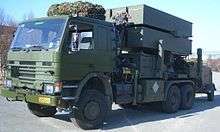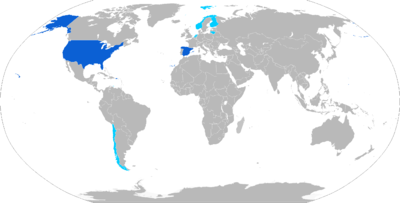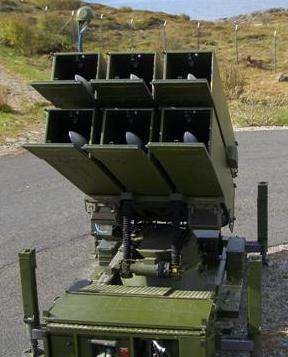NASAMS
| Norwegian Advanced Surface to Air Missile System | |
|---|---|
|
NASAMS launcher | |
| Type | Surface-to-air missile system |
| Place of origin | Norway |
| Service history | |
| In service | 1998– |
| Used by | Spain, United States |
| Production history | |
| Designer | Kongsberg Defence & Aerospace and Raytheon |
| Manufacturer | Kongsberg Defence & Aerospace |
NASAMS (Norwegian Advanced Surface to Air Missile System) is a distributed and networked medium to long range air-defence system. NASAMS was the first surface-based application for the AIM-120 AMRAAM (Advanced Medium Range Air-to-Air Missile). The missile itself is named SLAMRAAM (Surfaced Launched AMRAAM).[1]
Development
The Norwegian company Kongsberg Defence & Aerospace teamed up with Raytheon and initiated the NASAMS programme as a cooperative effort for the Royal Norwegian Air Force. The state-of-the-art network-centric air defence system NASAMS was declared fully operational capable in 1998 but had an initial operational capability as early as in 1994/95.
Until the late 1990s the RNoAF ground based air defence solution, also known as the Norwegian Solution (NORSOL), consisted of three different weapon systems; the 40mm Bofors L70 gun (controlled by the Oerlikon Contraves FCS2000 monopulse doppler tracking radar), the laser beam riding RBS 70 MANPADS system and the NASAMS. All three systems were integrated through the ARCS via field wires and radio. The ARCS maintained connection to higher echelons and ensured protection of friendly aircraft while preventing over- and underkill for all subordinate weapon systems. NASAMS capabilities[2] are enhanced by the system's networked and distributed nature.

Upgrade

The RNoAF together with KDA has conducted a mid-life update of the NASAMS, called NASAMS 2, and the upgraded version was first handed over to RNoAF in mid-2006. The major difference the two versions will be the use of Link 16 on NASAMS 2 as well as a better ground radar. Full operational capability (FOC) was expected for 2007.
Description
The system integrates US-built AN/MPQ-64 F1 Sentinel air defense radar and AIM-120 AMRAAM missiles with an indigenously developed Battle management C4I system called FDC, short for Fire Distribution Center. The FDC connected to a MPQ-64 radar forms an "Acquisition Radar and Control System" (ARCS). The missile has a horizontal range of up to 25 km.[3] Other sources cite a range of 'over 15 km',[4] but this depend on the missile version used.
AMRAAM missile range:
• AIM-120A/B: 55–75 km
• AIM-120C-5: >105 km
• AIM-120D (C-8): >180 km
Note that ranges for AAMs are estimated for head-on encounters for fast moving aircraft at an altitude, and the range is significantly shorter when the same missiles are launched from stationary ground platforms. Further dimensioning for a stationary ground-launched-missile system is its maximum altitude reach, which by rule of thumb is one third of its maximum horizontal range.
AMRAAM-ER
On 22 February 2015, Raytheon announced the development of the Extended Range upgrade to the NASAMS AMRAAM missile offering (AMRAAM-ER). Development work began in 2014, and the missile is actually an Evolved Sea Sparrow Missile using AMRAAM guidance. The first flight test took place in August 2016.[5] Production is expected by 2019.[6] Engagement envelope is expanded with a 50 percent increase in maximum range and 70 percent increase in maximum altitude.[7]
Service history
The NASAMS has been exported to the United States, with the NASAMS 2 upgrade having been exported to Finland, the Netherlands, Spain, Oman, and Chile.[8][9] Chile is though not mentioned as an official user, as Kongsberg stated: [10] «NASAMS is in operational use in Norway, Spain, USA, the Netherlands, Finland, and one undisclosed customer, and in production for Oman.»
Several NASAMS were used to guard air space over Washington, D.C. during the 2005 United States presidential inauguration, and are used to protect air space around the White House.[11][12][13]
Operators

This list shows only operators of the NASAMS system, excluding the upgraded NASAMS 2
Current operators
-
 Lithuania (ordered)
Lithuania (ordered) -
 Oman (ordered)
Oman (ordered) -
 United States - Used to protect high-value targets and Washington D.C.[14]
United States - Used to protect high-value targets and Washington D.C.[14]
Former operators
Possible operators
-
 Croatia - Croatian MoD has shown its interest to buy the surplus NASAMS systems from Norwegian military.
Croatia - Croatian MoD has shown its interest to buy the surplus NASAMS systems from Norwegian military.
See also
Notes
- ↑ "NASAMS - Surface Launched AMRAAM". kongsberg.com. Retrieved 21 December 2015.
- ↑ "Front page - Mil.no". Retrieved 24 December 2014.
- ↑ "Air Defense: SLAMRAAM Dies From Loneliness". www.strategypage.com. Retrieved 25 January 2016.
- ↑ Defense Update. "Finland Selects Nowregian/U.S. NASAMS for SA-11 Replacement". Retrieved 24 December 2014.
- ↑ Raytheon.com - Goes long, flies high - Raytheon’s new extended-range, surface-to-air missile will enhance proven air defense system (2016-10-06)
- ↑ Extended range air defence fires up - Shephardmedia.com, 23 February 2015
- ↑ Raytheon completes first AMRAAM-ER missile flight tests from NASAMS air defense system - Armyrecognition.com, 5 October 2016
- ↑ "Rapid Fire: 2010-06-22". Defense Industry Daily. 2010. Retrieved 2010-06-25.
- ↑ Dutch Order NASAMS-SLAMRAAM Air Defense Systems (2006-12-08)
- ↑ NASAMS September 2015
- ↑ Lund, Elisabeth (2006-02-16). "Norske våpen vokter presidenten". Økonomisk Rapport (in Norwegian). Archived from the original on 2006-05-19. Retrieved June 24, 2012.
- ↑ Christensen, Maj. Ola K. (2005-03-08). "The Norwegian Solution!". Battle Griffin 2005 (in Norwegian). Archived from the original on 2005-11-16. Retrieved June 24, 2012.
- ↑ NASAMS September 2015 : «Washington DC has since 2005 been protected 24/7 by NASAMS.»
- ↑ The Week, 16 April 2015
External links
| Wikimedia Commons has media related to NASAMS. |
- Official Norwegian Defence Force website NASAMS page
- Royal Norwegian Air Force Air and Missile Defence Team Page 1
- Royal Norwegian Air Force Air and Missile Defence Team Page 2
- Royal Norwegian Air Force Home Page
- NASAMS II (fact sheet in (Norwegian)
- Finland acquire NASAMS and radar system for 500 million eur April 28, 2009
